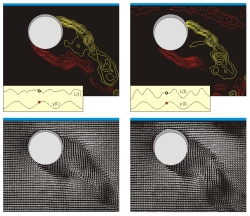You are here
Home ›Effect of Surface Contaminant on the Wake Structure of a Transversely Oscillating cylinder Adjacent to a Free-Surface
Effect of surface contaminant on the wake structure of a transversely oscillating cylinder adjacent to a free-surface. A cylinder in a uniform stream oscillates in the transverse direction beneath a free-surface. The Froude number and cylinder acceleration are sufficiently small that the free-surface remains in essentially an undisturbed state during the oscillation cycle. Images in the left column correspond to a clean free-surface and those in the right column to a contaminated free-surface, where the leading-edge of the contamination extends approximately 16 D upstream of the center of the cylinder. The patterns of vorticity shed from the cylinder for the clean and contaminated surface cases are remarkable similar. For the contaminated case, however, a low-velocity layer exists immediately beneath the free-surface at a location upstream of the cylinder. Downstream of the cylinder, a large-scale separated zone forms beneath the free-surface; it is evident in the velocity image. This zone is associated with a well-defined concentration of vorticity. The consequence of this surface vorticity effect is to increase the amplitude of the lift force, which has a double-peaked form, relative to the lower amplitude, less-organized trace corresponding to the clean surface. Reynolds number Re = 2,110 for the clean surface and Re = 2,250 for the contaminated surface. Amplitude A relative to the diameter D is A/D = 0.5. Frequency fe of controlled oscillation relative to natural Kármán frequency fo is fe/fo = 0.722 and 0.744 for left and right columns of images respectively. Minimum gap h between cylinder and free surface during oscillation cycle is h/D = 0.188.

Instantaneous patterns of vorticity and topology of streamlines, obtained via a technique of high-image-density particle image velocimetry, are employed to characterize quantitatively the near-wake of a cylinder undergoing large amplitude oscillations in a uniform flow.
